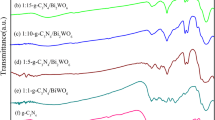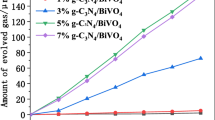Abstract
The phase transition process of a photocatalytic system from NaBiO3·2H2O to BiO2−x has been investigated to understand the important factors that affect photocatalytic performance in a composite system. It is found that a proper amount of BiO2−x on the surface of NaBiO3·2H2O could effectively suppress the electron/hole recombination and increase the exposed reactive sites for photocatalytic reaction. A fully covered BiO2−x on NaBiO3·2H2O results in a dramatical decrease of photocatalytic degradation of dye. An over long hydrothermal process can result in BiO2−x with reduced oxygen vacancies, which degrades the photocatalytic activity. Furthermore, the photocatalytic reduction ability of CO2 conversion has been investigated, indicating that the surface activity to different reactants also directly affects the catalytic performance. The investigation of the gradient phase transition process presents a clear guidance to construct a desired photocatalytic system, in addition to selecting gradient materials with suitable bandgap structure and a morphology with different fraction and distribution of each component. The defect evolution of each component during construction of a composite is also an important factor that should be optimized and considered in making a composite to achieve high photocatalytic efficiency.
Similar content being viewed by others
References
Kudo A, Miseki Y. Heterogeneous photocatalyst materials for water splitting. Chemical Society Reviews, 2009, 38(1): 253–278
Dong X, Li J, Xing Q, et al. The activation of reactants and intermediates promotes the selective photocatalytic NO conversion on electron-localized Sr-intercalated g-C3N4. Applied Catalysis B: Environmental, 2018, 232: 69–76
Jia Y, Wu C, Lee B W, et al. Magnetically separable sulfur-doped SnFe2O4/graphene nanohybrids for effective photocatalytic purification of wastewater under visible light. Journal of Hazardous Materials, 2017, 338: 447–457
Wang M, Artero V, Hammarström L, et al. Molecular catalysts for artificial photosynthesis: general discussion. Faraday Discussions, 2017, 198: 353–395
Chen L, Zhang W, Wang J, et al. High piezo/photocatalytic efficiency of Ag/Bi5O7I nanocomposite using mechanical and solar energy for N2 fixation and methyl orange degradation. Green Energy and Environment, 2021, online, https://doi.org/10.1016/j.gee.2021.04.009
Zhang W, Xing P, Zhang J, et al. Facile preparation of novel nickel sulfide modified KNbO3 heterojunction composite and its enhanced performance in photocatalytic nitrogen fixation. Journal of Colloid and Interface Science, 2021, 590: 548–560
Chen P, Chen L, Ge S, et al. Microwave heating preparation of phosphorus doped g-C3N4 and its enhanced performance for photocatalytic H2 evolution in the help of Ag3PO4 nanoparticles. International Journal of Hydrogen Energy, 2020, 45(28): 14354–14367
Zhuge Z, Liu X, Chen T, et al. Highly efficient photocatalytic degradation of different hazardous contaminants by CaIn2S4-Ti3C2Tx Schottky heterojunction: an experimental and mechanism study. Chemical Engineering Journal, 2021, 421: 127838
Zhang X, Tian F, Qiu L, et al. Z-Scheme Mo2C/MoS2/In2S3 dualheterojunctions for the photocatalytic reduction of Cr(VI). Journal of Materials Chemistry A, Materials for Energy and Sustainability, 2021, 9(16): 10297–10303
Bao S, Wang Y, Wei Z, et al. Amino-assisted AHMT anchored on graphene oxide as high performance adsorbent for efficient removal of Cr(VI) and Hg(II) from aqueous solutions under wide pH range. Journal of Hazardous Materials, 2021, 416: 125825
Bao S, Yang W, Wang Y, et al. Highly efficient and ultrafast removal of Cr(VI) in aqueous solution to ppb level by poly(allylamine hydrochloride) covalently cross-linked amino-modified graphene oxide. Journal of Hazardous Materials, 2021, 409: 124470
Ma H, Jia Y, Zhu G, et al. Study of cyano and hydroxyl groups modification on the properties of porous carbon nitride synthesized by using a salt assistant method. Applied Surface Science, 2020, 507: 144885
Cao S, Low J, Yu J, et al. Polymeric photocatalysts based on graphitic carbon nitride. Advanced Materials, 2015, 27(13): 2150–2176
Meng X, Zhang Z. Bismuth-based photocatalytic semiconductors: introduction, challenges and possible approaches. Journal of Molecular Catalysis A Chemical, 2016, 423: 533–549
McFarland E W, Metiu H. Catalysis by doped oxides. Chemical Reviews, 2013, 113(6): 4391–4427
Wang H, Zhang L, Chen Z, et al. Semiconductor heterojunction photocatalysts: design, construction, and photocatalytic performances. Chemical Society Reviews, 2014, 43(15): 5234
Liu X, Liu B, Li L, et al. Cu2In2ZnS5/Gd2O2S: Tb for full solar spectrum photoreduction of Cr(VI) and CO2 from UV/vis to near-infrared light. Applied Catalysis B: Environmental, 2019, 249: 82–90
Liu X, Liu H, Wang Y, et al. Nitrogen-rich g-C3N4@AgPd Mott-Schottky heterojunction boosts photocatalytic hydrogen production from water and tandem reduction of and. Journal of Colloid and Interface Science, 2021, 581: 619–626
Wang Y, Bao S, Liu Y, et al. Efficient photocatalytic reduction of Cr (VI) in aqueous solution over CoS2/g-C3N4-rGO nanocomposites under visible light. Applied Surface Science, 2020, 510: 145495
Feng Z, Zeng L, Zhang Q, et al. In situ preparation of g-C3N4/Bi4O5I2 complex and its elevated photoactivity in methyl orange degradation under visible light. Journal of Environmental Sciences (China), 2020, 87: 149–162
Wei Z, Zhu Y, Guo W, et al. Enhanced photocatalytic overall water splitting via MOF-derived tetragonal BiVO4-based solid solution. Chemical Engineering Journal, 2021, 414: 128911
Wei Z, Zhu Y, Guo W, et al. Enhanced twisting degree assisted overall water splitting on a novel nano-dodecahedron BiVO4-based heterojunction. Applied Catalysis B: Environmental, 2020, 266: 118664
Usai S, Obregón S, Becerro A I, et al. Monoclinic-tetragonal heterostructured BiVO4 by yttrium doping with improved photocatalytic activity. Journal of Physical Chemistry C, 2013, 117(46): 24479–24484
Li H, Hu D, Li Z, et al. Emerging layered BiO2−x for photocatalysis: status, challenges, and outlook. Sustainable Energy& Fuels, 2020, 4(11): 5378–5386
Li J, Wu X, Pan W, et al. Vacancy-rich monolayer BiO2−x as a highly efficient UV, visible, and near-infrared responsive photocatalyst. Angewandte Chemie, 2018, 130(2): 500–504
Mao Y, Wang P, Li L, et al. Unravelling the synergy between oxygen vacancies and oxygen substitution in BiO2−x for efficient molecular-oxygen activation. Angewandte Chemie International Edition, 2020, 59(9): 3685–3690
Kumada N, Kinomura N, Sleight A W. Ion-exchange reaction of Na+ in NaBiO3·nH2O with Sr2+ and Ba2+. Solid State Ionics, 1999, 122(1–4): 183–189
Rao P S, Hayon E. Experimental determination of the redox potential of the superoxide radical. Biochemical and Biophysical Research Communications, 1973, 51(2): 468–473
Jia Y, Li S, Gao J, et al. Highly efficient (BiO)2CO3-BiO2−x-graphene photocatalysts: Z-Scheme photocatalytic mechanism for their enhanced photocatalytic removal of NO. Applied Catalysis B: Environmental, 2019, 240: 241–252
Wang M, Tan G, Zhang D, et al. Defect-mediated Z-scheme BiO2−x/Bi2O2.75 photocatalyst for full spectrum solar-driven organic dyes degradation. Applied Catalysis B: Environmental, 2019, 254: 98–112
Jia Y, Li S, Ma H, et al. Oxygen vacancy rich Bi2O4-Bi4O7-BiO2−x composites for UV-vis-NIR activated high efficient photocatalytic degradation of bisphenol A. Journal of Hazardous Materials, 2020, 382: 121121
Li J, Li Y, Zhang G, et al. One-dimensional/two-dimensional core-shell-structured Bi2O4/BiO2−x heterojunction for highly efficient broad spectrum light-driven photocatalysis: faster interfacial charge transfer and enhanced molecular oxygen activation mechanism. ACS Applied Materials & Interfaces, 2019, 11(7): 7112–7122
Wang J, Liu Z, Liu Z. BiO2−x/NaBiO3 hybrid composites: facile synthesis, enhanced photocatalytic activity and mechanism. Solid State Sciences, 2019, 95: 105935
Dias A, Moreira R L. Crystal structure and phonon modes of ilmenite-type NaBiO3 investigated by Raman and infrared spectroscopies. Journal of Raman Spectroscopy: JRS, 2010, 41(6): 698–701
Li L, Liu Z, Guo L, et al. NaBiO3/BiO2−x composite photocatalysts with post-illumination “memory” activity. Materials Letters, 2019, 234: 30–34
Lu Y, Huang Y, Zhang Y, et al. Oxygen vacancy engineering of Bi2O3/Bi2O2CO3 heterojunctions: implications of the interfacial charge transfer, NO adsorption and removal. Applied Catalysis B: Environmental, 2018, 231: 357–367
Mao Y, Wang P, Li L, et al. Unravelling the synergy between oxygen vacancies and oxygen substitution in BiO2−x for efficient molecular-oxygen activation. Angewandte Chemie International Edition, 2020, 59(9): 3685–3690
Li L, Chen T, Liu Z, et al. Novel BiO2−x photocatalyst: typical hierarchical architecture and commendable activity. Materials Letters, 2018, 212: 267–270
Jia Y, Ma H, Liu C. Au nanoparticles enhanced Z-scheme AuCoFe2O4/MoS2 visible light photocatalyst with magnetic retrievability. Applied Surface Science, 2019, 463: 854–862
Ding Y, Yang F, Zhu L, et al. Bi3+ self-doped NaBiO3 nanosheets: facile controlled synthesis and enhanced visible light photocatalytic activity. Applied Catalysis B: Environmental, 2015, 164: 151–158
Wu J, Chen Y, Pan L, et al. Multi-layer monoclinic BiVO4 with oxygen vacancies and V4+ species for highly efficient visible-light photoelectrochemical applications. Applied Catalysis B: Environmental, 2018, 221: 187–195
Rossell M D, Agrawal P, Borgschulte A, et al. Direct evidence of surface reduction in monoclinic BiVO4. Chemistry of Materials, 2015, 27(10): 3593–3600
Li X, Zhang W, Li J, et al. Transformation pathway and toxic intermediates inhibition of photocatalytic NO removal on designed Bi metal@defective Bi2O2SiO3. Applied Catalysis B: Environmental, 2019, 241: 187–195
Wang J, Wang Z, Huang B, et al. Oxygen vacancy induced band-gap narrowing and enhanced visible light photocatalytic activity of ZnO. ACS Applied Materials & Interfaces, 2012, 4(8): 4024–4030
Liu Q, Wang F, Lin H, et al. Surface oxygen vacancy and defect engineering of WO3 for improved visible light photocatalytic performance. Catalysis Science & Technology, 2018, 8(17): 4399–4406
Sachs M, Park J S, Pastor E, et al. Effect of oxygen deficiency on the excited state kinetics of WO3 and implications for photocatalysis. Chemical Science (Cambridge), 2019, 10(22): 5667–5677
Tauc J, Grigorovici R, Vancu A. Optical properties and electronic structure of amorphous germanium. Physica Status Solidi. B, Basic Research, 1966, 15(2): 627–637
Niu M, Cheng D, Cao D. Understanding the mechanism of photocatalysis enhancements in the graphene-like semiconductor sheet/TiO2 composites. Journal of Physical Chemistry C, 2014, 118(11): 5954–5960
Fan H, Wang D, Xie T, et al. The preparation of high photocatalytic activity nano-spindly Ag-BiVO4 and photoinduced carriers transfer properties. Chemical Physics Letters, 2015, 640: 188–193
Pei D, Gong L, Zhang A, et al. Defective titanium dioxide single crystals exposed by high-energy {001} facets for efficient oxygen reduction. Nature Communications, 2015, 6(1): 8696
Pan X, Yang M, Fu X, et al. Defective TiO2 with oxygen vacancies: synthesis, properties and photocatalytic applications. Nanoscale, 2013, 5(9): 3601–3614
Acknowledgements
This research was supported by the Basic Science Research Program through the National Research Foundation of Korea funded by the Ministry of Science, ICT and Future Planning (2017R1D1A1B03032265 and 2019R1A2C1086881). SEM characterization in this research was supported by Nano-material Technology Development Program through the National Research Foundation of Korea (NRF) funded by the Ministry of Science, ICT and Future Planning (2009-0082580).
Author information
Authors and Affiliations
Corresponding author
Supporting Information
Rights and permissions
About this article
Cite this article
Ma, H., Jia, Y., Bae, J. et al. Factors affecting photocatalytic performance through the evolution of the properties due to the phase transition from NaBiO3·2H2O to BiO2−x. Front. Energy 16, 471–482 (2022). https://doi.org/10.1007/s11708-021-0778-4
Received:
Accepted:
Published:
Issue Date:
DOI: https://doi.org/10.1007/s11708-021-0778-4




